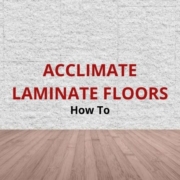Can You Install Laminate Flooring Over Tile?
Laminate flooring is a popular flooring option because it offers the warmth and beauty of wood flooring, but it’s cheaper and easier to work with. It’s a floating floor, which means you can lay it down on top of a variety of subfloor materials. But can you install laminate flooring over tile? Yes!
You have a lot of options when you update the flooring in a house, and one of them is whether you can skip grueling tearout work and just put new flooring over the old. Tile floors are one of the hardest to remove yourself. Picture chipping away with a heavy chisel and hammer to clear your floor one small chunk at a time. If you can skip that, why wouldn’t you?
If you want to know how to install a laminate floor over old ceramic tiles, you just might be in luck. This article will tell you the factors to think about before you get started to ensure you have a successful install.
Can you install laminate over an old tile floor? The answer is yes, but you need to make sure the tiles are still in good shape and the floor is level. Also, check that you won’t be adding too much thickness to the floor and ruining doorways or transitions. Finally, use a good underlayment to protect the floor from moisture and squeaks.
What to Consider Before Installing Laminate Floors Over Tile
Installing laminate over tile isn’t the right move 100% of the time. Pay attention to the following to make sure it’s going to work out:
Condition of the Tile Floor
Laminate floors need to go on top of a sturdy and clean subfloor surface. Tile floors are usually good for this because they’re strong and durable. Sometimes if tile floors were installed badly or they are really old, they can crumble and break.
Don’t try to install a floating laminate floor on top of broken tiles. A chip here and there can be ok, but if there are whole pieces of tile missing or the grout is turning to dust, you risk the laminate floor coming apart later because it won’t be supported from below.
Leveling the Floor
It’s also important that laminate flooring goes down on top of a very level subfloor. There should be minimal difference in floor height. A good rule is less than ¼ inch variation across a six-foot span. You can test this with a long metal level or straightedge. If the level rocks back and forth, or if there is a gap between the middle of the level and the floor, that section of floor is not level.
If the floor has a big slope or especially if the tiles are badly uneven, you need to level it up first. You can use a concrete patch mix and a six- or twelve-inch metal putty knife to level up the low spots. You can also consider a thin self-leveling mix, but you need to make sure the floor is watertight for this. It’s also more expensive than concrete patch mix.
Floor leveling mixes contain water, which can create a humidity issue if you install the flooring over top too soon. Use a big fan and give the leveling material several days to dry completely.
Added Height of the Floor
This really comes into play in two situations: doorways and transitions.
Doors usually have just a small gap between the floor and the bottom of the door. This gap isn’t always big enough to add a new layer of flooring without interfering with the swing of the door.
The easiest way to test this out is to take a plank of the new flooring along with a scrap of whatever type of underlayment you will install, stack them on top of each other, and slide them under the door. Remember to test the door not just when it’s closed, but also when the door is at its fully open position — and everywhere in between.
If the door opens and closes with some space left over when you perform this test, you’re good. If not, you need to either saw some length off of the bottom of the door or remove the whole tile floor first.
If your ceilings or doors are already short or if you have really tall people living in the house, you should probably remove the tile rather than adding to the height with new laminate on top.
As for transitions, the important thing is to make sure you have a plan for how to transition the new, higher floor to existing thresholds or places where the tile currently meets another type of flooring.
For example, you may need to install a trim or transition piece. These usually need to be glued or nailed to the subfloor (below the tile), so you might need to cut the neighboring flooring back slightly. Transitions are different in every house. It’s just important to figure out how you will complete them ahead of time so you can order the right materials and you end up with a nice finished product.
Underlayment
Underlayment is a foam or paper material that you roll out and seal across the whole surface of the room between the subfloor and the laminate. It helps dissipate the noise of footsteps on the laminate (really important if you’re installing over tile), creates a moisture barrier, and helps the flooring to float freely.
The flooring manufacturer will usually tell you what kind of underlayment to use. You may find one that’s specifically for use on concrete or tile subfloors. A little bit thicker one will help with minor variation in flatness. There are lots of choices, so pick one that seems to fit your purposes and make sure to install it according to the instructions.
Potential Problems of Installing Laminate Over Tile
Watch out for these issues that people run into when they install laminate over tile floors. There is usually something you can do to prevent them if you see the warning signs, so study up:
Excess Moisture
Laminate floors are sensitive to moist environments. They can cause the flooring to expand or contract too much and pull apart the locking tongue-and-groove system. With a lot of water, it can get really ugly with warping, cupping, or buckling.
Tile floors, on the other hand, do great in humid or even wet environments like kitchens, basements, and laundry rooms. If your laminate is going into a room like this, you might want to get a moisture meter and test to make sure the room is pretty dry. If there is a drain in the floor or if water regularly drips onto the tile, you need to correct these issues before you install the laminate floor. Laminate won’t hold up under wet conditions.
Underlayment can go a long way to protect the laminate from excess moisture. You may even think about painting the floor with a moisture-barrier paint before you roll out the underlayment.
Uneven Tile
Uneven subfloors can cause all kinds of problems for your laminate floor. Minor problems include a clicking, creaking, or hollow sound when the floorboards flex underfoot. More serious problems can be buckling laminate floorboards that separate from one another and leave you with ugly gaps in your laminate flooring.
Your subfloor (in this case tile) must be as flat and level as possible. The instructions above on leveling the floor can help, but they can only do so much. Be wise and don’t risk your new laminate flooring by installing it on a shoddy and uneven tile surface.
Debris Under the Flooring
This goes for all flooring installations, but especially for laminate over a hard subfloor like tile: clean everything!
Even if your tile floor is flat and level, a small rock or chunk of grout that sticks up can cause all the problems of a majorly uneven floor. Take the time to sweep two or more times and preferably run a vacuum with a hose over the entire floor.
If the tile is messy with grout or other construction materials stuck on, take a metal putty knife and scrape them off. Get the flooring clean before you do anything else.
Table of Contents





